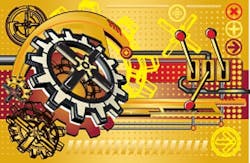Enterprise View: Transforming ERP to Sustain High Performance
June 2, 2010
3 min read
For auto suppliers, being prepared for potential tough times ahead will be as crucial as capitalizing on the global economic recovery.Despite some of the most dire marketplace conditions witnessed in decades, some auto supplier manufacturers have managed to excel. According to a recent Accenture study on what makes a high-performance business, a set of leading suppliers generated more than half of their revenues outside their home countries, yet managed to handle operations using half the working capital of their competitors. Then too, they earned nearly five points more margin than peers and returned six more points on invested capital, producing much greater value for shareholders.Operating excellence and Lean processes that help optimize assets and swiftly integrate acquisitions were key factors in achieving this level of performance. But these building blocks to success would not have been possible without the support of enterprise resource planning (ERP). There is an approach to transforming ERP in a way that can greatly aid companies in their pursuit of operational excellence and superior global manufacturing to sustain high performance in both good and not-so-good times.First, the complexity of managing information technology (IT) enterprise-wide systems to support global operations can be daunting. But one way to effectively do so and achieve optimal results is to bring together enterprise systems and enabling technologies with business processes and practices, such as Lean Manufacturing, to sharpen competitive capabilities and have a greater impact in the marketplace. A key component of this approach should involve using IT modular applications that can be tailored to fit the specific processes and practices based on the needs of suppliers’ original equipment manufacturer (OEM) customers. By employing this strategy, suppliers will be able to satisfy customers, and at the same time, focus on areas that will provide competitive differentiation, such as supplier relationship management.Transformed ERPThe benefits of applying ERP in this manner can be numerous. Beyond helping to create competitive differentiation, using a modular concept also can streamline initiatives and the costs associated with their implementation, as well as promote a higher level of customer satisfaction. Adopting this strategy accelerates value creation for customers and will enable companies to begin the implementation of customer deliverables at an advanced stage in the design phase, saving time. Delivery timeframes can be shortened by up to 25 percent, depending on the size of the company involved and the complexity of its needs.Greater predictability and lower implementation risks are among the benefits too. Business disruptions can wreak havoc on the overall manufacturing process, not to mention OEM relations. This application of ERP is designed to increase predictability, and thus reduce risk of error. But perhaps the most critical benefit is that it enables a better focus on business outcomes by providing a low-cost, flexible, operating model that scales rapidly and efficiently to meet the changing demands of markets and customers in the supplier marketplace.The emergence of the economy from the global downturn will be welcome news. But for the business world, and the auto supplier industry in particular, it also will serve as a reminder of how quickly business conditions can change. Companies that can transform their ERP systems to more effectively support their global manufacturing efforts will be better prepared to face today’s competitive challenges, as well as new ones that will undoubtedly confront the industry in the best and worst of times.James Robbins, [email protected], is a senior executive for Accenture, a global management consulting, technology services and outsourcing company.
Subscribe to Automation World's RSS Feeds for Columns & Departments
About the Author
Sign up for our eNewsletters
Get the latest news and updates

Leaders relevant to this article:
